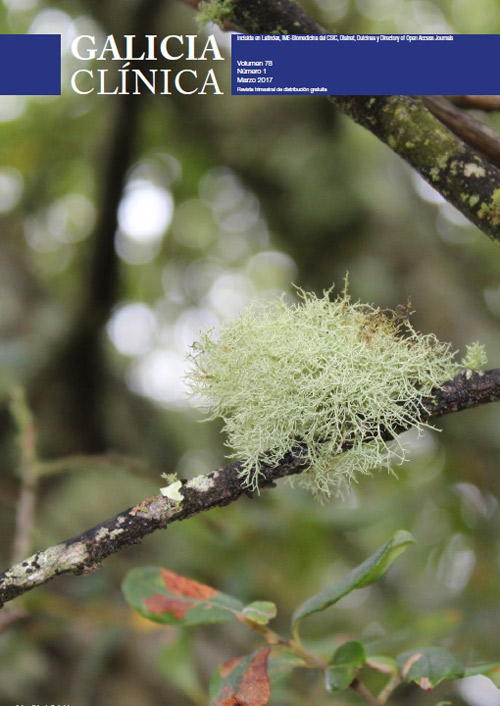Galicia Clínica by Sociedad Gallega de Medicina Interna is licensed under a Creative Commons Reconocimiento-NoComercial-SinObraDerivada 4.0 Internacional License.
Created from galiciaclinica.info.
Similar Articles
- Olaya Huergo Fernández, Andoni Paisan Fernández, Lucía Ordieres Ortega, Superior and inferior vena cava syndrome , Galicia Clínica: Vol. 85 No. 2 (2024): Galicia Clinica - Official Journal of the SOGAMI
- Marta Araújo Morgado Vilaça, Helena Magalhães, Fernanda Estevinho, Main structural oncologic emergencies in lung cancer: a single center analysis , Galicia Clínica: Vol. 82 No. 4 (2021): Galicia Clinica - Official Journal of the SOGAMI
- Susana Travassos Cunha, Catarina Pereira, Acrocyanosis , Galicia Clínica: Vol. 80 No. 3 (2019): Galicia Clinica - Official Journal of the SOGAMI
- José Antonio Díaz Peromingo, Vena cava filter and pregnancy: some certainties and many doubts , Galicia Clínica: Vol. 82 No. 4 (2021): Galicia Clinica - Official Journal of the SOGAMI
- João Faria, Rui Moço, Duplication of the Inferior Vena Cava , Galicia Clínica: Vol. 73 No. 3 (2012): Galicia Clinica - Official Journal of the SOGAMI
- Hélio Martins, David Paiva, Margarida Cerqueira, Jorge Cotter, Burkitt lymphoma as an axillary adenopathy in an immunosuppressed patient , Galicia Clínica: Vol. 82 No. 2 (2021): Galicia Clinica - Official Journal of the SOGAMI
- Catarina Teles Neto, Marta Valentim, Filipa Pedro, Pedro Luís, Ana Gameiro, Luís Siopa, Evans syndrome – atypical presentation of a rare lymphoma , Galicia Clínica: Vol. 83 No. 1 (2022): Galicia Clinica - Official Journal of the SOGAMI
- Julián Castro Castro, José Antonio Torre Eiriz, Óscar Álvarez-Calderon Iglesias, Eros Yamel Moreno Morales, Primary skull base lynphoma presenting as acute ophtalmoplegia , Galicia Clínica: Vol. 84 No. 1 (2023): Galicia Clinica - Official Journal of the SOGAMI
- Tiago Alves, Inês Coelho, Mário Santos, Teresa Inês, Mantle Cell Lymphoma, a less frequent presentation. , Galicia Clínica: Vol. 81 No. 3 (2020): Galicia Clinica - Official Journal of the SOGAMI
- José Leite, José Cardoso, José Almeida, Daniela Marado, Undetermined febrile syndrome and panniculitis - a rare case of subcutaneous panniculitis-like T-cell lymphoma , Galicia Clínica: Vol. 82 No. 1 (2021): Galicia Clinica - Official Journal of the SOGAMI
You may also start an advanced similarity search for this article.
Most read articles by the same author(s)
- Alexandra Mesquita, Fátima Braga, Angeles Peteiro, Carlos Sottomayor, Extragastrointestinal Stromal Tumor – report of a rare case , Galicia Clínica: Vol. 78 No. 1 (2017): Galicia Clinica - Official Journal of the SOGAMI

